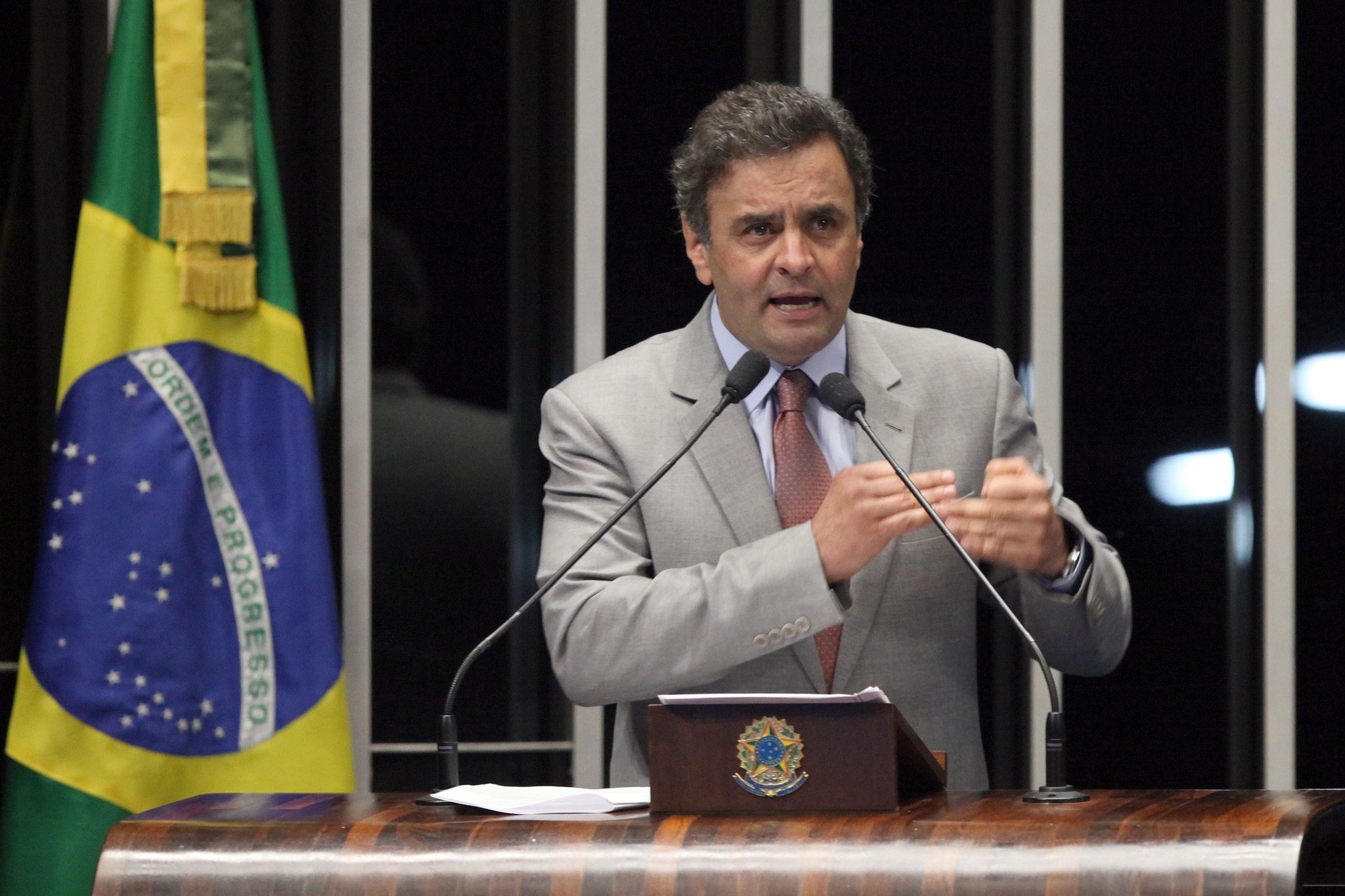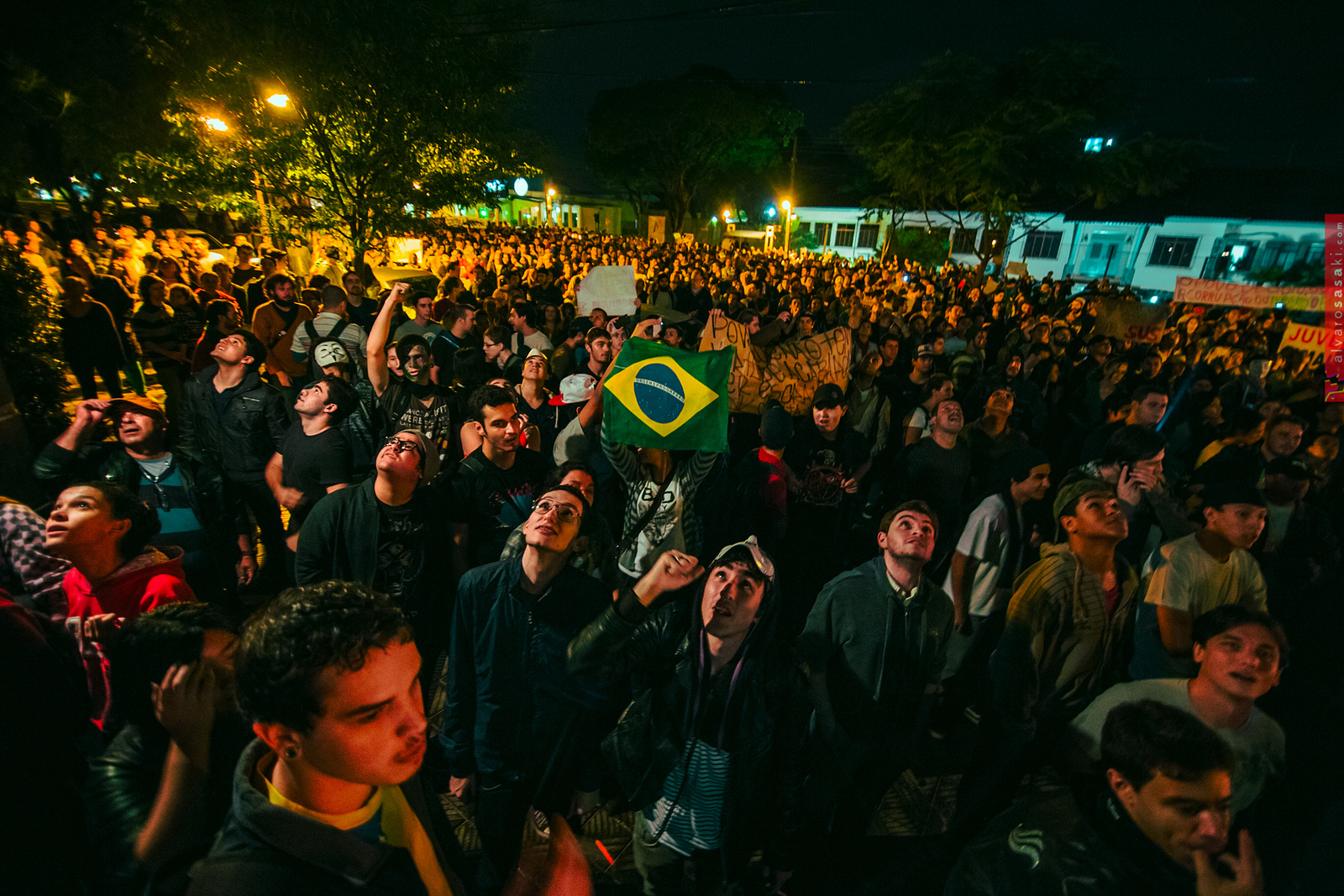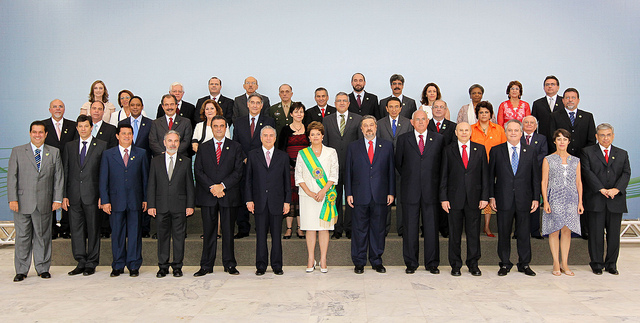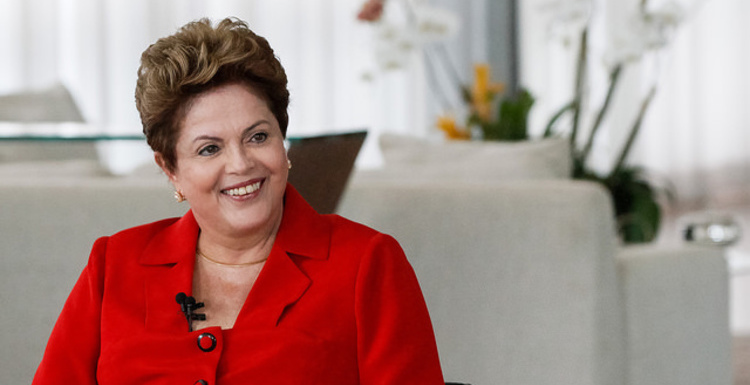Brazil’s Presidential Elections: What Now?
Brazil’s presidential elections on October 26 resulted in a narrow reelection for President Dilma Rousseff, the Workers’ Party (PT, Partido dos Trabalhadores). Her opponent Aécio Neves, from the center right Brazilian Social Democratic Party (PSDB, Partido da Social Democracia Brasileira), was ahead in the polls by a narrow three percent margin in mid-October (51-49). However, as election day approached, Rousseff pulled ahead with a six percent advantage in the late polls (53-47). Rousseff ultimately won with a 51.6 percent of the vote against 48.4 percent for Neves.[1]
Both Neves and Rousseff ran negative and aggressive campaigns, with continual accusations of corruption against each other. Mainstream media groups such as O Globo and Veja tended to be on the side of Neves, promoting his orthodox electoral platform, while smearing Rousseff.[2] For instance, in an article two days before the elections, Veja accused president Rousseff as well as ex-president Ignacio Lula da Silva of knowing about the on-going, major corruption scandal involving the improper use of Petrobrás funds for election campaigning.[3] Analyst João Feres Junior concluded that for each negative article on Neves in the leading Brazilian newspapers O Globo, O Estado de São Paulo, and Folha de São Paulo,there were at least three negative articles on Rousseff.[4] In international press, such as The Economist, Neves was predictably endorsed based on a range of arguments that boiled down to Brazil’s need for reforms and the hard-hitting policies that he promised to implement.[5]
Voting behavior in Brazil was clearly divided along regional and class lines. The majority of low-income voters in the most impoverished parts of the country and the most resource-deprived areas in large cities voted for Rousseff. On the other hand, Neves commanded a majority of the vote in the richest regions and with the higher income blocs of voters. In the end, Neves did not manage to convince Brazilian voters – although he came close to doing so.
A Folha de São Paulo article points out that the breath of Rousseff’s win (72 percent of the vote) was of great importance to her electoral victory and came from the Northeast, Brazil’s poorest region.[6] Voters in the North and Northeast have good reason for wishing the PT government to stay in power with its continued commitment to reduce poverty and inequality. These regions have experienced the biggest change during PT’s 12-year governance in terms of growth and steady improvement of its living standards.[7]
Interestingly, Rousseff’s 53-47 percent win against Neves in the Southeastern state of Minas Gerais was also very important not only because Neves served as state governor between 2002 and 2010, but also because it is one of the riches states in Brazil. Rousseff’s victory in Minas Gerais is noteworthy since it contradicts the general trend of Brazil’s electoral behavior, and is the home state for both candidates.
Two Competing Projects for Brazil
The election was not merely a question of whether voters wanted to retain the benefits and improvements they would gain with the PT, or those they wished to receive with the PSDB. The two candidates promoted two distinct national projects on how to foster the country’s economic and social development.[8]

Image by: George Gianni/PSDB. Taken from: https://www.flickr.com/photos/psdbminasgerais/9142079303
Neves called for a market-oriented project characterized by economic openness, tax reductions, strict budgets, and a reduced role of the state to best stimulate renewed economic growth. He promised to maintain the popular Bolsa Familia (Family Allowance)cash transfer program that distributes small monthly economic allowances to poor families based on children’s school attendance and mandatory vaccinations.[9] According to his national project for Brazil, the country should develop closer ties with traditional Western powers like the United States, the European Union (EU), and their linked markets.[10]
During the campaign, Neves specifically criticized the PT government’s macroeconomic policies. He argued that the poor quality of these policies explained low economic growth in Brazil, experienced during much of Rousseff’s time in office. Additionally, Neves blamed Rousseff’s poor policies for the rise in the inflation level and the implied risk of economic instability. He promised to re-establish the sound macroeconomic policies that the PT under Lula previously had implemented. His macroeconomic policy consisted of three aspects, namely fiscal austerity, a flowing exchange rate, and a monetary policy leading to an appropriate inflation level.[11] Armínio Fraga, former President of the Brazilian Central Bank, and Neves’ candidate to be finance minister, criticized the government for its all to moderate economic growth and high inflation. He believed, instead of using subsidized credit from public banks, the government should pursue a policy that would ensure low interest rates in the economy in general.[12]
Rousseff favored a mixed economy with a key role of the state to manage economic growth with the active use of public banks. She continued to emphasize and expand on social policies targeted at the poor as well as promoting universal social services and rights. At the same time, she stressed a continued focus on fiscal responsibility, promising to raise the primary surplus from 2 percent to 2.5 percent in 2015.[13] Guido Mantega, the current Finance Minister, defended the importance of public banks and argued that without the Brazilian National Development Bank (BNDES), Brazil could not have assured the same volume of investments and economic growth during the international financial crisis.[14] According to Rousseff’s project for Brazil, the country should continue the autonomist line of diversifying relations with a priority given to regional integration and effective South-South cooperation.
Future Outlook
At this moment, the future outlook for the country remains uncertain. Financial markets and São Paulo’s stock exchange responded negatively to the victory of Rousseff and the coalition government led by the PT, but are now in recovery.[15] On the first day after the elections when the stock exchange BM&FBOVESPA was taking a beating, Rousseff took an unworried attitude arguing that the drop, while bigger than the plunge in other stock exchanges, was part of an international tendency. The government did not feel hurried to react to the drop but decided to initiate a broad dialogue with different groups in society, including all productive sectors with a view on developing appropriate economic policies. She underlined that Brazil would not need drastic measures, as when former President Lula first came to power, since the economic situation currently was not anywhere as serious as it was in 2002.[16]
Nevertheless, although Brazil does not face immediate destabilizing tendencies from the international financial markets, the re-elected government in Brasilia faces significant challenges. The government must assure renewed economic growth in a context of mild economic recession and difficulties in reaching the government’s goals related to its budget and inflation rates.
This is a complex task in a context where the population expects a further expansion of the Brazilian welfare state, which has been in construction since the introduction of democracy in 1985. Such an expansion would require further budgetary expenses, which in turn would make a balanced budget more difficult to achieve.[17] An expansion of inclusionary social policies and universal welfare state services has been a priority during the ruling epoch of the PT and one, which its supporters expect to continue. Rousseff stressed in her presidential speech on the night of the election that she would take economic measures to re-invigorate economic growth. Her goal is to maintain the economy to guarantee high levels of job creation. Additionally, she will strive to ensure that real incomes do not shrink as a result of high inflation.[18]
A Need for a Shared Vision
Brazil needs to unite politically in order to develop a compelling vision for its future. Rousseff’s discourse after the presidential election suggests that she is determined to generate a broad dialogue with society and has to listen to those who are skeptical of her policies, which turn out to be wrong. She underscored the importance of political reform in her presidential speech also promising to listen to the voices from the streets. However, political reform and broad inclusion of civil society groups, including social movements, is a major challenge. Members of both the Congress and Senate have opposed giving civil society a leading role in political reform.
Rousseff argued for political reform through a plebiscite last year in the context of the wave of social protests that swept over Brazil in mid-2013, which was met with pervasive opposition. After her reelection, Rousseff announced that she would propose either a plebiscite or a referendum that includes the people as decision-makers to the political and electoral system reforms.[19] The reforms will concern some of the same propositions she presented last year, such as changes to the financial system for election campaigns, party coalitions, the election of deputies in the Senate, and ending secret voting in the Senate.[20] Trying to push the process ahead, right after her reelection, Rousseff proposed a law project that would create popular councils within the corridors of Brazilian public administration as a way to allow civil society participation within the formal political institutions, although decisions would continue to be made by the authorities.
However, the Chamber of Deputies fiercely rejected it. Veja celebrated in an article this dismissal of what they consider a “Bolivarian project,” comparing the PT-led government’s ideology with that of Venezuela’s government (which was meant as an insult to the PT). Among Rousseff’s political opposition, Venezuela’s government is perceived in a negative light and as a radical populist government.[21] On social media, the “Bolivarian project” was defied by Congressman Antonio Imbassahy, who added thatthe dismissal proved that Brazil does not accept Chavismo from Venezuela.

Image by: Alvaro Sasaki. Taken from: https://www.flickr.com/photos/alvarosasaki/11224424003
The inclusion of social movements has been a contested topic by the social protesters in Brazil last year, particularly in those protests leading up to the World Cup. Reforms of the political system were among the demands. However, there is neither an agreement about the content of the reforms, nor the decision process that should lead to the reforms.
Rousseff’s Foreign Policy and Beyond
Brazilian voters value the positive contribution states make to national development. They acted on this belief by voting for Rousseff. It is a government that can be expected to emphasize social inclusion to further strengthen the welfare state. In addition, it will focus against the conservative position in favor of a “minimal state” and the flexibilization of labor laws.[22]
There is no reason to believe Brazilian foreign policy will change significantly. The PT government is expected to remain the same, following a trend dating back to 2003. Brazil will promote a multi-polar world order and jealously defend its sovereignty and autonomy. It will continue giving a high degree of priority to South-South cooperation. This means that there will be an emphasis on developing closer economic and political links with developing countries from different world regions. Similarly, Brazil can be expected to coordinate foreign policy dialogue with southern coalition partners in various multilateral negotiation arenas such as the World Trade Organization (WTO), the Group of Twenty (G20), and the United Nations regarding environmental issues such as global climate change. This suggests that the Global North centered on the Western heartland of the United States and the EU is likely to face a continued challenge from Brazil and its emerging power coalitions.[23] These emerging powers from the Global South, such as Brazil, are becoming more prominent in terms of leadership and are beginning to greatly influence various world regions and multilateral institutions. Brazil is expected to continue to push for this agenda with the PT’s reelection.

Image by: Roberto Stuckert Filho/PR, Blog do Planalto. Taken from: https://www.flickr.com/photos/blogplanalto/5315325355
Rousseff’s reelection and this new era of the PT coalition means that the coming years will be a period of continuity of national development that has been pursued by PT governments since 2003. Regarding economic development policy, an ambitious social agenda will be pursued. For instance, state banks will be used to raise credit for productive investments. At the same time, the government will maintain its autonomy focus and continue prioritizing relations with developing countries.
Analysts differ on how to evaluate this policy approach. Some analysts see this strategic state-oriented national development project as the key to explaining Brazil’s impressive economic growth and strengthened position on the international political scene since 2003. On the contrary, other critics find that the active involvement of the state in the economy helps to explain Brazil’s current economic stagnation and its weak competitiveness, at least in the manufacturing sector. Some find Brazil’s priority for South-South cooperation runs counter to its national interests. The critics argue the country would be better served by a renewed engagement with the EU and the United States for free trade agreements with these two traditional partners. Nevertheless, it will be a challenge for the Rousseff’s government to foster renewed economic growth and create a less polarized political atmosphere. It will be inherently interesting to monitor Brazil as it moves towards broader national dialogue and international cooperation to move the country forward.
By: Associate Professor Steen Fryba Christensen and Marie Kolling, Ph.D. Fellow, are guest scholars with the Council on Hemispheric Affairs.
They are from the Department of Culture and Global Studies, Aalborg University and the Department of Anthropology, Copenhagen University, Denmark.
Please accept this article as a free contribution from COHA, but if re-posting, please afford authorial and institutional attribution. Exclusive rights can be negotiated. For additional news and analysis on Latin America, please go to: LatinNews.com and Rights Action.
Featured Image: Dilma Rousseff participa de sabatina do Uol, Folha, SBT e Jovem Pan. Brasília. By: Ichiro Guerra. Taken from: Sala de Imprensa
References
[1] Datafolha. “Dilma (53%) Assume Liderança da Disputa Presidencial; Aécio Tem 47%,” Oct. 24, 2014. Accessed Oct. 28, 2014: http://datafolha.folha.uol.com.br/eleicoes/2014/10/1537506-dilma-53-assume-lideranca-da-disputa-presidencial-aecio-tem-47.shtml ; Winter, Brian and Alonso Soto. “Leftist Rousseff Narrowly Wins Second Term in Brazil,” Reuters, Oct. 26, 2014. Accessed Oct. 28, 2014: http://www.reuters.com/article/2014/10/26/us-brazil-election-idUSKCN0IE03L20141026
[2] Reed, Drew. “Dilma’s Reelection Proves “Citizen Kane” Style Media Still Alive and Well in Brazil,” Disinformation, Oct. 31, 2014. Accessed Nov. 3, 2014: http://disinfo.com/2014/10/dilmas-reelection-proves-citizen-kane-style-media-still-alive-well-brazil/ ; TeleSUR. “Rousseff Victory Came Despite Right-Wing Media Bias,” Oct. 27, 2014. Accessed Nov. 3, 2014: http://www.telesurtv.net/english/news/Rousseff-Victory-Came-Despite-Right-Wing-Media-Bias-20141027-0007.html
[3] Bonin, Robson. ”Dilma e Lula Sabiam de Tudo, Diz Alberto Youssef à PF,” Veja, Oct. 24, 2014. Accessed Oct. 28, 2014:http://veja.abril.com.br/noticia/brasil/dilma-e-lula-sabiam-de-tudo-diz-alberto-youssef-a-pfhttp://veja.abril.com.br/noticia/brasil/dilma-e-lula-sabiam-de-tudo-diz-alberto-youssef-a-pf
[4] Feres Junior, João “Folha Padrão Veja: O DNA Marrom Da Mídia Brasileira,” Manchetômetro, Oct. 25, 2014. Accessed Oct. 31, 2014: http://www.manchetometro.com.br/artigos/folha-padrao-veja-o-dna-marrom-da-midia-brasileira/
[5] The Economist. ”Why Brazil Needs Change, “Oct. 18, 2014. Accessed Oct. 28, 2014: http://www.economist.com/news/leaders/21625780-voters-should-ditch-dilma-rousseff-and-elect-cio-neves-why-brazil-needs-change
[6]Mendonça, Ricardo.“Vantagem no Nordeste e vitória em Minas Gerais dão impulso a Dilma,” Folha de São Paulo, Oct. 26, 2014. Accessed Oct. 31, 2014:http://www1.folha.uol.com.br/poder/2014/10/1538819-vantagem-no-nordeste-e-vitoria-em-minas-gerais-dao-impulso-a-dilma.shtml
[7] Maldonado, Raquel. “Renda no Nordeste é a que mais cresce, e diferença para regiões mais ricas cai, aponta IBGE,” UOL Notícias, Sep. 8, 2010. Accessed Oct. 31, 2014: http://noticias.uol.com.br/especiais/pnad/2010/ultimas-noticias/2010/09/08/renda-no-nordeste-e-a-que-mais-cresce-e-diferenca-para-regioes-mais-ricas-cai-aponta-ibge.jhtm
[8] 20minutos. ”Brasil vota, con su economía herida: Rousseff o Neves y sus dos modelos opuestos,” Oct. 26, 2014. Accessed Oct. 28, 2014: http://www.20minutos.es/noticia/2276812/0/elecciones-brasil-26-octubre/dilma-rousseff/aecio-neves/
[9] Watts, Jonathan. “Dilma Rousseff Favourite in Brazil’s Presidential Election Runoff,” The Guardian, Oct. 26, 2014. Accessed October 28, 2014: http://www.theguardian.com/world/2014/oct/26/dilma-rousseff-favourite-brazil-presidential-election-aecio-neves
[10] Lopes, Marina. “Brazil’s Neves Would Improve Ties with United States: Adviser,” Reuters, Oct. 10, 2014. Accessed Oct. 28, 2014: http://www.reuters.com/article/2014/10/10/us-brazil-election-usa-idUSKCN0HZ1XN20141010
[11] Neumann, Denise. “Compare as propostas de governo de Dilma e Aécio,” Valor Econômico, Oct. 10, 2014. Accessed Oct. 31, 2014: http://www.valor.com.br/eleicoes2014/3745160/compare-propostas-de-governo-de-dilma-e-aecio
[12] “Mantega e Armínio debatem inflação e crise,” Folha de São Paulo, Oct. 10, 2014. Accessed Oct. 31, 2014: http://www1.folha.uol.com.br/fsp/especial/189974-mantega-e-arminio-debatem-inflacao-e-crise.shtml
[13]Neumann, Denise. “Compare as propostas de governo de Dilma e Aécio,” Valor Econômico, Oct. 10, 2014. Accessed Oct. 31, 2014: http://www.valor.com.br/eleicoes2014/3745160/compare-propostas-de-governo-de-dilma-e-aecio
[14] Soares, Pedro and Lucas Vettorazzo. “Mantega e Armínio debatem inflação e crise,” Folha de São Paulo, Oct. 10, 2014. Accessed Oct. 31, 2014: http://www1.folha.uol.com.br/fsp/especial/189974-mantega-e-arminio-debatem-inflacao-e-crise.shtml
[15] Takar, Téo. “Bovespa se recupera, na expectativa de nova equipe econômica de Dilma,” Valor Econômico, Oct. 28, 2014. Accessed Oct. 31, 2014: http://www.valor.com.br/financas/3754052/bovespa-se-recupera-na-expectativa-de-nova-equipe-economica-de-dilma
[16]Peres, Bruno. “Medidas econômicas serâo objeto de amplo diálogo, diz Dilma,” Valor Econômico, Oct. 27, 2014. Accessed Oct. 31, 2014: http://www.valor.com.br/eleicoes2014/3751686/medidas-economicas-serao-objeto-de-amplo-dialogo-diz-dilma
[17] Langlois, Jill. “In Brazil, reelected President Rousseff’s uphill economic battle has just begun,” Fortune, Oct. 28, 2014. Accessed Oct. 28, 2014: https://fortune.com/2014/10/28/brazil-dilma-rousseff-economy/
[18]Folha de São Paulo. “Leia a integra do discurso de vitória de Dilma Rousseff” Oct. 26, 2014. Accessed Oct. 31, 2014: http://www1.folha.uol.com.br/poder/2014/10/1538780-leia-a-integra-do-discurso-de-vitoria-de-dilma-rousseff.shtml
[19] Globo, G1. “Dilma admite plebiscito ou referendo para reforma política,” Oct. 28, 2014. Accessed Oct. 31, 2014: http://g1.globo.com/politica/eleicoes/2014/noticia/2014/10/dilma-admite-plebiscito-ou-referendo-para-reforma-politica.html
[20] Globo, G1. “Entenda 5 temas sugeridos por Dilma para plebiscito sobre reforma política,” Jul. 2, 2013. Accessed Oct. 31, 2014: http://g1.globo.com/politica/noticia/2013/07/entenda-5-temas-sugeridos-por-dilma-para-plebiscito-sobre-reforma-politica.html ;
Krakovics, Fernanda, Isabel Braga, Germano Oliveira, and Tiago Dantas. “Congresso já reage à ideia de plebiscito proposto por Dilma,” O Globo, Oct. 28, 2014. Accessed Oct. 31, 2014: http://oglobo.globo.com/brasil/congresso-ja-reage-ideia-de-plebiscito-proposto-por-dilma-14381463
[21]Mattos, Marcela “Dois dias depois da eleição, Câmara derruba decreto bolivariano de Dilma,” Veja, Oct. 28, 2014. Accessed Oct. 31, 2014: http://veja.abril.com.br/noticia/brasil/dois-dias-depois-da-eleicao-camara-derruba-decreto-bolivariano-de-dilma
[22]Jakobsen, Kjeld. “A vitória de Dilma e o future da política externa,” Grupo de Reflexão sobre Relações Internacionais en Carta Capital, Oct. 27, 2014. Accessed Oct. 31, 2014: http://www.cartacapital.com.br/blogs/blog-do-grri/a-vitoria-da-dilma-e-o-futuro-da-politica-externa-3797.html
[23] Christensen, Steen Fryba. 2012: “South-South Relations in Brazil’s Response to the Challenges of Globalization”, pp. 231-252 in Manuela Nilsson and Jan Gustafsson (editors) Latin American Responses to Globalization in the 21st Century. Palgrave Macmillan, Houndmills, Basingstoke, Hampshire RG21 6XS:, 2012.


